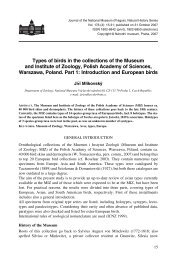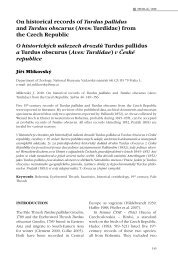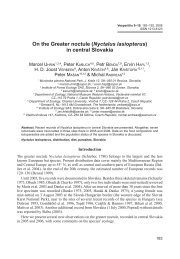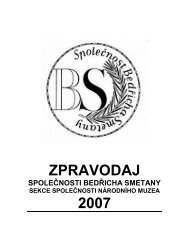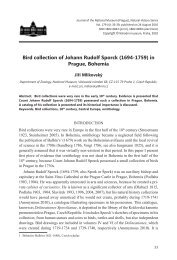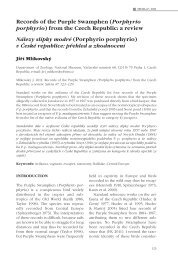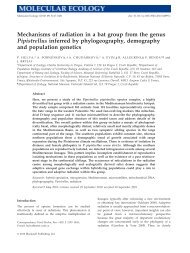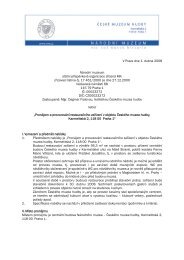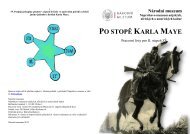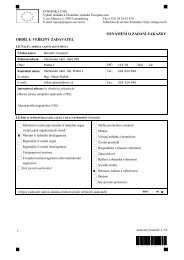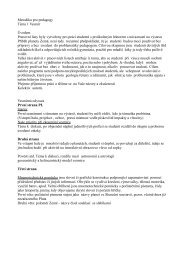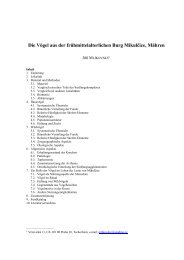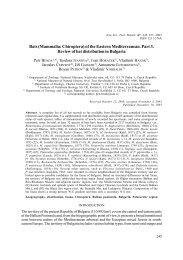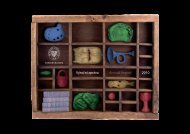Middle Pleistocene birds of Hundsheim, Austria - Národní muzeum
Middle Pleistocene birds of Hundsheim, Austria - Národní muzeum
Middle Pleistocene birds of Hundsheim, Austria - Národní muzeum
You also want an ePaper? Increase the reach of your titles
YUMPU automatically turns print PDFs into web optimized ePapers that Google loves.
Journal <strong>of</strong> the National Museum (Prague), Natural History Series<br />
Vol. 177 (7): 69-82; published on 26 February 2009<br />
ISSN 1802-6842 (print), 1802-6850 (electronic)<br />
Copyright © <strong>Národní</strong> <strong>muzeum</strong>, Praha, 2009<br />
<strong>Middle</strong> <strong>Pleistocene</strong> <strong>birds</strong> <strong>of</strong> <strong>Hundsheim</strong>, <strong>Austria</strong><br />
Jiří Mlíkovský<br />
Department <strong>of</strong> Zoology, National Museum, Václavské náměstí 68, CZ-115 79 Praha 1, Czech Republic;<br />
e-mail: jiri.mlikovsky@nm.cz<br />
Ab s t r a c t. <strong>Middle</strong> <strong>Pleistocene</strong> karst fissure <strong>of</strong> <strong>Hundsheim</strong>, <strong>Austria</strong>, yielded remains <strong>of</strong> 36 modern<br />
bird species. The avifauna has a boreal character. The <strong>birds</strong> preferably inhabited mixed forests<br />
and dry cold steppes.<br />
Key-w o r d s . Aves, middle <strong>Pleistocene</strong>, <strong>Hundsheim</strong>, <strong>Austria</strong>.<br />
Introduction<br />
<strong>Pleistocene</strong> <strong>birds</strong> have been found in many localities <strong>of</strong> Europe, but most <strong>of</strong> them are late<br />
<strong>Pleistocene</strong> in age, while the early and middle <strong>Pleistocene</strong> record remains rather limited<br />
(Tyrberg 1998, 2008, Mlíkovský 2002a,b). A significant fossiliferous locality, generally<br />
known as <strong>Hundsheim</strong> in literature, was discovered during the mining activities in<br />
the karstic Hainburg Hills between Hainburg, Bad Deutsch-Altenburg and Hunds heim<br />
(Wessely 1961) in 1900 (Toula 1901, 1902, 1907, Wüst 1907, Freudenberg 1908, 1914)<br />
and subsequently excavated at irregular intervals until 1960. The <strong>Hundsheim</strong> fissure,<br />
which does not exist anymore, was located on southern slopes <strong>of</strong> Hainburg Hills, NW <strong>of</strong><br />
<strong>Hundsheim</strong>, ca. 260 m a.s.l. In addition to other fossils, the fissure <strong>of</strong> <strong>Hundsheim</strong> yielded<br />
a rich micromammal fauna (Kormos 1937, Rabeder 1972, 1981), which allowed dating<br />
the excavated taphocenosis in the earliest middle <strong>Pleistocene</strong>, particularly in the biozone<br />
MQ 2A (sensu Mlíkovský 2002b), which corresponds with the biozone Q 3 1 (sensu<br />
Horáček & Ložek 1988), Tarkő substage (sensu Jánossy 1986), or MNQ-zone 22 (sensu<br />
Guérin 1982).<br />
The <strong>birds</strong> from <strong>Hundsheim</strong> were for the first time mentioned by Freudenberg (1908,<br />
1914; see also Toula 1907). Subsequent excavations (until 1951) yielded more avian remains,<br />
which were described by Jánossy (1974). The latter author revised also some <strong>of</strong><br />
the avian remains formerly mentioned by Freudenberg (1914), but remarked that most <strong>of</strong><br />
Freudenberg‘s material has been lost. Later, new avian remains from <strong>Hundsheim</strong> were<br />
collected in 1960 by Peter Ullrich, and a part <strong>of</strong> the Freudenberg‘s „lost“ material has<br />
been rediscovered in the University <strong>of</strong> Wien. Below I present a revised avifaunal list <strong>of</strong><br />
<strong>Hundsheim</strong>, based on the revision <strong>of</strong> Freudenberg‘s (1914) and Jánossy‘s (1974) mater-<br />
69
ial, and on the original identification <strong>of</strong> more recently excavated remains. Bird bones<br />
described in this paper are deposited in the Department <strong>of</strong> Paleontology, University <strong>of</strong><br />
Wien, Wien, <strong>Austria</strong> (UWPI 1889/51-88).<br />
The sequence <strong>of</strong> families and species follows Voous (1977). Minimum numbers <strong>of</strong><br />
individuals (MNI) were calculated according to Grayson (1984). Quaternary stratigraphy<br />
follows Mlíkovský (2002b). Measurements were taken according to Driesch (1976).<br />
Museum abbreviations are as follows: JMP = J. Mlíkovský, Praha, Czechia (private<br />
collection, to be transferred to the NMP); NMP = National Museum, Praha, Czechia;<br />
USNM = United States National Museum, Washington, DC, USA; UWPI = Institute <strong>of</strong><br />
Paleontology, University <strong>of</strong> Wien, Wien, <strong>Austria</strong>.<br />
Systematic list<br />
Accipitridae<br />
Gyps fulvus (Hablizl, 1783)<br />
Mat e r i a l: proximal end <strong>of</strong> left humerus, phalanx I digiti 3; MNI = 1.<br />
Re m a r k s: Jánossy (1974) correctly wrote that both these bones are morphologically similar<br />
to the same elements <strong>of</strong> modern Gyps fulvus (which is supported by my observations),<br />
but inexplicably referred them to the extinct vulture Gyps melitensis Lydekker<br />
1890, originally described from the middle <strong>Pleistocene</strong> <strong>of</strong> Malta (Lydekker 1890).<br />
Gyps melitensis seems to have been a Mediterranean species (Sánchez Marco 2007;<br />
see also Mlíkovský 2002a), but its records from Central Europe are invalid (Mlíkovský<br />
1998, 2002a).<br />
In addition, Jánossy (1974) attributed to Gyps melitensis an ungual phalanx, because<br />
he found it similar to the same element <strong>of</strong> Gyps fulvus. This specimen is non-avian in<br />
fact, belonging to a large cat, probably Panthera sp. (I. Horáček, pers. communication).<br />
Aegypius monachus (Linné, 1766)<br />
Mat e r i a l: proximal end <strong>of</strong> right radius, proximal end <strong>of</strong> left tarsometatarsus, phalanx I<br />
digiti 1, ungual phalanx; MNI = 1.<br />
Re m a r k s: Jánossy (1974) correctly mentioned that this radius fragment and both phalanges<br />
are morphologically similar to the same elements <strong>of</strong> the modern Aegypius<br />
mochanchus (which is supported by my observations), but inexplicably attributed<br />
them to the extinct vulture Gyps melitensis Lydekker, 1890 The tarsometatarsus fragment<br />
was believed by Jánossy (1974) to be similar to the same element <strong>of</strong> Gyps fulvus,<br />
but it differs from Gyps and agrees with Aegypius in having: (1) proximal foramen<br />
deeply excavated and with proximally sharply bordered groove, (2) tubercle for musculus<br />
tibialis antiquus narrow and distinct, (3) groove between the calcaneal ridges <strong>of</strong><br />
hypotarsus broad, and (4) different position <strong>of</strong> the outer proximal foramen.<br />
In addition, Jánossy (1974) listed among the material attributed to Gyps melitensis<br />
a cervical vertebra, said to be similar to the vertebrae <strong>of</strong> Gyps fulvus. I found in his<br />
70
mater ial two such vertebrae. Both <strong>of</strong> them are generally similar to the cervical vertebrae<br />
<strong>of</strong> vultures, but differ from them in having posterior end rounded, not V-shaped.<br />
Accipiter nisus (Linné, 1758)<br />
Mat e r i a l: distal end <strong>of</strong> right ulna; MNI = 1<br />
Re m a r k s: This ulna was not available to Jánossy (1974).<br />
Aquila sp.<br />
Mat e r i a l: ungual phalanx; MNI = 1.<br />
Falconidae<br />
Falco tinnunculus Linné, 1758<br />
Mat e r i a l: distal end <strong>of</strong> left humerus, distal end <strong>of</strong> right humerus, distal end <strong>of</strong> left carpometacarpus,<br />
distal end <strong>of</strong> left tibiotarsus, distal end <strong>of</strong> right tarsometatarsus; MNI<br />
= 1.<br />
Falco vespertinus Linné, 1766<br />
Mat e r i a l: fragmentary right mandibula, 2 distal ends <strong>of</strong> right tarsometatarsi; MNI = 2.<br />
Re m a r k s: These bones were not available to Jánossy (1974).<br />
Phasianidae<br />
Bonasa bonasia (Linné, 1758)<br />
Mat e r i a l: right humerus, proximal end <strong>of</strong> right humerus, 2 distal ends <strong>of</strong> right ulnae;<br />
MNI = 2.<br />
Me a s u r e m e n t s: humerus: maximum length = 49.9 mm, proximal width = 14.3 mm, distal<br />
width = 10.5 mm; ulna: distal width = 7.3 mm.<br />
Re m a r k s: Jánossy (1974) attributed these bones to the alleged extinct hazelhen Tetrastes<br />
[= Bonasa] praebonasia Jánossy 1974, described by him from the middle <strong>Pleistocene</strong><br />
(MQ 2A) locality Tarkő (layer 12) in Hungary (Jánossy 1974). However, the latter<br />
species was found to be synonymous with the modern Bonasa bonasia (Linné, 1758)<br />
by Mlíkovský (2002a). The hazelhen bones from <strong>Hundsheim</strong> are inseparable from the<br />
same elements <strong>of</strong> the modern Bonasa bonasia.<br />
Tetrao tetrix Linné, 1758<br />
Mat e r i a l: distal end <strong>of</strong> right tibiotarsus, proximal end <strong>of</strong> left tarsometatarsus; MNI = 1.<br />
Re m a r k s: Jánossy (1974) tentatively attributed both these bones to the extinct grouse<br />
Lyrurus [= Tetrao] partium Kretzoi 1962, described from the early <strong>Pleistocene</strong> (MQ<br />
1a) <strong>of</strong> Betfia 2, Romania (Kretzoi 1962). Similarly as Jánossy (1974), I was not able to<br />
find any morphological or mensural differences between the bones from <strong>Hundsheim</strong><br />
and the same elements <strong>of</strong> the modern Tetrao tetrix. Lyrurus partium Kretzoi, 1962 is<br />
synonymous with the modern Tetrao tetrix (Linné, 1758) (Mlíkovský 2002a).<br />
71
Perdix perdix (Linné, 1758)<br />
Mat e r i a l: right humerus, distal end <strong>of</strong> left radius, distal end <strong>of</strong> left femur, left tarsometatarsus;<br />
MNI = 1.<br />
Me a s u r e m e n t s: humerus: maximum length = 45.5 mm, proximal width = 12.4 mm; radius:<br />
distal width = 5.0 mm; tarsometatarsus: maximum length = 40.7 mm, proximal<br />
width = 7.0 mm, distal width = 7.6 mm.<br />
Coturnix coturnix (Linné, 1758)<br />
Mat e r i a l: 2 distal ends <strong>of</strong> left humeri; MNI = 2.<br />
Otididae<br />
Otis tarda Linné, 1758<br />
Mat e r i a l: proximal end <strong>of</strong> right radius, proximal end <strong>of</strong> left carpometacarpus; MNI = 1.<br />
A proximal part <strong>of</strong> a tarsometatarsus <strong>of</strong> this species was figured by Freudenberg (1914,<br />
pl. XX, fig. m), but already Jánossy (1974: 223) reported that it is missing from the<br />
collection.<br />
Me a s u r e m e n t s: carpometacarpus: proximal width = 24.0 mm.<br />
Re m a r k s: Jánossy (1974) tentatively attributed these bones to the extinct bustard Otis<br />
lambrechti Kretzoi 1941, described from the earliest <strong>Pleistocene</strong> (MQ 1b) <strong>of</strong> Betfia 5,<br />
Romania (Kretzoi 1941). However, the latter species is synonymous with the modern<br />
Otis tarda Linné, 1758 (Mlíkovský 2002a). I found the Otis bones from <strong>Hundsheim</strong><br />
inseparable from the same elements <strong>of</strong> the modern Otis tarda.<br />
Scolopacidae<br />
Scolopax rusticola Linné, 1758<br />
Mat e r i a l: cranial end <strong>of</strong> right coracoid; MNI = 1.<br />
Columbidae<br />
Columba palumbus Linné, 1758<br />
Mat e r i a l: distal end <strong>of</strong> left tarsometatarsus; MNI = 1.<br />
Strigidae<br />
Glaucidium passerinum (Linné, 1758)<br />
Mat e r i a l: left tarsometatarsus; MNI = 1.<br />
Strix aluco (Linné, 1758)<br />
Mat e r i a l: distal end <strong>of</strong> right carpometacarpus; MNI = 1.<br />
Re m a r k s: Jánossy (1974) attributed this bone to the alleged fossil species Strix intermedia<br />
Jánossy, 1972, described by him from the middle <strong>Pleistocene</strong> (MQ 2A) locality Tarkő,<br />
Hungary (Jánossy 1972). Strix intermedia Jánossy, 1972 was synonymized with the<br />
modern Strix aluco (Linné, 1758) by Mlíkovský (2002a; see also Mlíkovský 2003).<br />
72
Apodidae<br />
Apus apus (Linné, 1758)<br />
Mat e r i a l: 2 left coracoids, right humerus, 5 left ulnae, 2 right ulnae, right carpometacarpus,<br />
proximal end <strong>of</strong> right carpometacarpus, distal end <strong>of</strong> left tibiotarsus; MNI = 5.<br />
Me a s u r e m e n t s: humerus: maximum length = 12.4 mm.<br />
Re m a r k s: Jánossy (1974) described on the basis <strong>of</strong> the 13 bones and bone fragments listed<br />
above a new subspecies Apus apus palapus Jánossy 1974, without selecting a holotype<br />
or illustrating any <strong>of</strong> the bones. Mlíkovský (2002a: 207) designed the humerus UWPI<br />
1889/63 as the lectotype <strong>of</strong> Apus apus palapus and placed Apus apus palapus Jánossy,<br />
1974 in the synonymy <strong>of</strong> the modern Apus apus (Linné, 1758). Jánossy (1974) believed<br />
that the humerus <strong>of</strong> palapus is more slender than the humeri <strong>of</strong> the modern Apus<br />
apus, being <strong>of</strong> the same length, but having distal width less than is that in modern<br />
Swifts. Nevertheless, my examination <strong>of</strong> the lectotype showed that the humerus is<br />
slightly abraded, which diminished its distal width by ca. 0.2-0.3 mm. Taking this into<br />
account, the measurements <strong>of</strong> the lectotypical humerus fall within the cluster <strong>of</strong> data<br />
for the modern Apus apus swifts, as presented by Jánossy (1974, fig. 2).<br />
Meropidae<br />
Merops apiaster Linné, 1758<br />
Mat e r i a l: right humerus; MNI = 1.<br />
Me a s u r e m e n t s: maximum length = 31.1 mm.<br />
Upupidae<br />
Upupa epops Linné, 1758<br />
Mat e r i a l: right coracoid, proximal end <strong>of</strong> left ulna; MNI = 1.<br />
Re m a r k s: Jánossy (1974) erected on the basis <strong>of</strong> the coracoid (UWPI 1889/65) a new<br />
hoopoe species Upupa phoeniculides, particularly because it differed markedly from<br />
modern Hoopoes in the shape <strong>of</strong> the ossified bridge between tuberculum craniale and<br />
processus scapularis, which was not smooth and narrow, but ragged and rectang ular<br />
in the fossil. I examined this character in coracoids <strong>of</strong> ca. 10 European Hoopoes and<br />
could confirm Jánossy‘s (1974) observation. However modern Upupa epops from<br />
Egypt, Syria, Israel, China, Thailand, Zimbabwe and South Africa (ca. 20 specimens<br />
examined in JMP, NMP and USNM) all posses the ossified bridge <strong>of</strong> the same type<br />
as does the fossil from <strong>Hundsheim</strong>. Hence, the osteological difference, upon which<br />
Jánossy (1974) based this species, is attributable to intraspecific variation. Upupa<br />
phoeniculides Jánossy 1974 was thus synonymized with the modern Upupa epops<br />
Linné 1758 by Mlíkovský (2002a).<br />
Picidae<br />
Dendrocopos major (Linné, 1758)<br />
Mat e r i a l: distal end <strong>of</strong> left carpometacarpus, distal end <strong>of</strong> left tarsometatarsus; MNI = 1.<br />
73
Re m a r k s: Jánossy (1974) created on the basis <strong>of</strong> these two bones from <strong>Hundsheim</strong>, and<br />
an almost complete tarsometatarsus from the similarly old locality Tarkő, Hungary, a<br />
new subspecies Dendrocopos major submajor Jánossy 1974, which he later elevated to<br />
a species rank (Jánossy 1980). Mlíkovský (2002a) synonymized Dendrocopos major<br />
submajor Jánossy, 1974 with the modern Picoides [= Dendrocopos sensu Voous 1977]<br />
major (Linné, 1758). The diagnosis <strong>of</strong> the subspecies was based by Jánossy (1974) on<br />
three main points, which are rewritten and discussed below:<br />
(1) The tarsometatarsus from Tarkő is morphologically identical to the same element<br />
<strong>of</strong> Dendrocopos major, but is longer (Jánossy 1974: 234). The length <strong>of</strong> this specimen<br />
(not examined by me) is either 24.5 mm (Jánossy 1974: 234) or 24.4 mm (Jánossy<br />
1980: 25, 1981: 382). This by ca. 6 % less than the longest tarsometatarsus <strong>of</strong> Dendrocopos<br />
major measured by Jánossy (1981; 26 mm, n = 12). Hence, Jánossy (1981)<br />
himself eliminated this character.<br />
(2) The tarsometatarsus fragment from <strong>Hundsheim</strong> is from an even larger specimen<br />
(Jánossy 1974: 234). I examined this fragment, which is not meaningfully measurable,<br />
and could not find any differences from the same element <strong>of</strong> modern Dendrocopos<br />
major.<br />
(3) The carpometacarpus from <strong>Hundsheim</strong> has shaft robust as in the modern Dendrocopos<br />
leucotos Bechstein, 1803, but the relation between the distal width and length <strong>of</strong><br />
the carpometacarpus falls within the variability <strong>of</strong> the same element <strong>of</strong> Dendrocopos<br />
major. This is inexplicable, because proximal part <strong>of</strong> the bone (ca. 1.5-2.0 mm) is<br />
missing, and measuring the length <strong>of</strong> the bone is thus impossible. Comparisons <strong>of</strong> the<br />
carpometacarpus from <strong>Hundsheim</strong> with the same elements <strong>of</strong> modern Dendrocopos<br />
major showed that there is no difference between them in size or shape.<br />
Jánossy (1976, 1980) attributed a proximal humerus fragment from Tarkő to submajor,<br />
showing at the same time, that it does not differ from the same element <strong>of</strong> the modern<br />
Dendrocopos major, its proximal width being 9.8 mm in the fossil, and 9.7-10.7 mm<br />
in Recent specimens (n = 10). In addition, Jánossy (1981) attributed to submajor a<br />
tarsometatarsus from the early <strong>Pleistocene</strong> (MQ 1a) <strong>of</strong> Deutsch-Altenburg, <strong>Austria</strong>.<br />
This tarsometatarsus is inseparable from the same element <strong>of</strong> the modern Dendrocopos<br />
major (Mlíkovský 1997).<br />
Dendrocopos medius (Linné, 1758)<br />
Mat e r i a l: left carpometacarpus; MNI = 1.<br />
Hirundinidae<br />
Hirundo rustica Linné, 1758<br />
Mat e r i a l: 10 left and 4 right humeri, proximal ends <strong>of</strong> one left and 7 right humeri, distal<br />
ends <strong>of</strong> one left and 3 right humeri; MNI = 14. Tentatively referred are 3 coracoids, 15<br />
ulnae, 6 carpometacarpi, 1 ulna, and 1 tarsometatarsus.<br />
74
Turdidae<br />
Erithacus rubecula (Linné, 1758)<br />
Mat e r i a l: left humerus; MNI = 1.<br />
Re m a r k s: This humerus was not available to Jánossy (1974).<br />
Luscinia svecica (Linné, 1758)<br />
Mat e r i a l: proximal end <strong>of</strong> right humerus; MNI =1.<br />
Re m a r k s: This humerus was not available to Jánossy (1974).<br />
Phoenicurus phoenicurus (Linné, 1758)<br />
Mat e r i a l: left humerus, anterior part <strong>of</strong> coracoid (according to Jánossy 1974).<br />
Re m a r k s: Jánossy (1974) assigned to this species left humerus and cranial fragment <strong>of</strong><br />
coracoid. However, I did not found the tube with these remains in the collection. I was<br />
thus not able to check the species identity <strong>of</strong> these bones and, consequently, I prefer to<br />
delete the species from the faunal list <strong>of</strong> <strong>Hundsheim</strong>.<br />
Oenanthe cf. oenanthe (Linné, 1758)<br />
Mat e r i a l: left humerus; MNI = 1.<br />
Re m a r k s: Several species <strong>of</strong> the genus Oenanthe Vieillot, 1816 <strong>of</strong> this size class, which<br />
cannot be discerned osteologically, live in the southern Palearctic now, but only one<br />
<strong>of</strong> them, Oenanthe oenanthe, reaches northern parts <strong>of</strong> this region (Panov 1974, Hagemeier<br />
& Blair 1997, Snow & Perrins 1998).<br />
Turdus sp. (large species)<br />
Mat e r i a l: left humerus, proximal ends <strong>of</strong> a left and a right humerus, distal ends <strong>of</strong> one<br />
left and 2 right humeri; MNI = 3.<br />
Re m a r k s: These humeri fall in the size class <strong>of</strong> the modern European species Turdus<br />
viscivorus/pilaris/torquatus. Some <strong>of</strong> them were listed by Jánossy (1974) as „Turdus<br />
sp. I“.<br />
Turdus sp. (medium sized species)<br />
Mat e r i a l: 2 left humeri, proximal end <strong>of</strong> right humerus, distal ends <strong>of</strong> 4 right humeri;<br />
MNI = 4.<br />
Re m a r k s: These humeri fall in the size class <strong>of</strong> the modern European species Turdus<br />
merula/philomelos. Some <strong>of</strong> them were included by Jánossy (1974) in his „Turdus<br />
sp. I“, and some in his „Turdus sp. II“, which he erroneously believed to be <strong>of</strong> Turdus<br />
iliacus size. Turdus humeri <strong>of</strong> the size <strong>of</strong> Turdus iliacus (smaller than “medium sized”<br />
species) were not recorded in <strong>Hundsheim</strong>.<br />
75
Sylviidae<br />
Phylloscopus sp.<br />
Mat e r i a l: right humerus (broken); MNI = 1.<br />
Muscicapidae<br />
Muscicapa striata (Pallas, 1764)<br />
Mat e r i a l: proximal end <strong>of</strong> right humerus; MNI = 1.<br />
Ficedula parva (Bechstein, 1794)<br />
Mat e r i a l: mandibula, left humerus; MNI = 1.<br />
Re m a r k s: These bones were not available to Jánossy (1974).<br />
Paridae<br />
Parus sp. A<br />
Mat e r i a l: proximal end <strong>of</strong> right humerus; MNI = 1.<br />
Re m a r k s: This humerus is smaller than the same element <strong>of</strong> the modern Parus major<br />
Linné, 1758 and Parus lugubris Temminck, 1820, the largest <strong>of</strong> western Palearctic tits,<br />
but larger than that <strong>of</strong> all other tits <strong>of</strong> this region, with the possible exception <strong>of</strong> Parus<br />
cinctus. It cannot be properly identified at the species level. Jánossy (1974) tentatively<br />
identified this humerus as that <strong>of</strong> Parus major, which cannot be accepted because <strong>of</strong><br />
the size difference.<br />
Parus sp. B<br />
Mat e r i a l: proximal end <strong>of</strong> left humerus; MNI = 1.<br />
Re m a r k s: Jánossy (1974) identified this humerus as belonging to Parus cf. palustris Linné.<br />
However, several species <strong>of</strong> tit <strong>of</strong> this size-class inhabit the western Palearctic, that<br />
cannot be properly distinguished from each other on the basis <strong>of</strong> their humeri.<br />
Corvidae<br />
Garrulus glandarius (Linné, 1758)<br />
Mat e r i a l: distal end <strong>of</strong> left tibiotarsus; MNI = 1.<br />
Re m a r k s: Jánossy (1974) erroneously identified this bone fragment as belonging to Pica<br />
pica. A left coracoid <strong>of</strong> a subadult individual, also assigned by Jánossy (1974) to Pica<br />
pica, cannot be properly identified, but may belong to Garrulus glandarius as well.<br />
Pyrrhocorax graculus (Linné, 1766)<br />
Mat e r i a l: sternal end <strong>of</strong> left coracoid, proximal ends <strong>of</strong> 2 right humeri, proximal end <strong>of</strong><br />
right ulna, distal end <strong>of</strong> left ulna, proximal end <strong>of</strong> right tarsometatarsus, distal end <strong>of</strong><br />
left tarsometatarsus; MNI = 2.<br />
Re m a r k s: Some <strong>of</strong> these bones (coracoid, 2 humeri, and an ulna) were incorrectly assigned<br />
by Jánossy (1974) to Pica pica, while the remaining were not available to him.<br />
76
Pyrrhocorax pyrrhocorax (Linné, 1758)<br />
Mat e r i a l: distal end <strong>of</strong> left tibiotarsus; MNI = 1.<br />
Re m a r k s: This specimen was not available to Jánossy.<br />
Corvus corax Linné, 1758<br />
Mat e r i a l: distal end <strong>of</strong> right humerus, distal end <strong>of</strong> right femur, left tarsometatarsus;<br />
MNI = 1.<br />
Re m a r k s: These bones were not available to Jánossy (1974).<br />
Fringillidae<br />
Loxia curvirostra Linné, 1758<br />
Mat e r i a l: right humerus; MNI = 1.<br />
Re m a r k s: This humerus was not available to Jánossy (1974).<br />
Coccothraustes coccothraustes (Linné, 1758)<br />
Mat e r i a l: 2 left humeri, proximal end <strong>of</strong> right humerus; MNI = 2.<br />
Re m a r k s: Jánossy (1974) tentatively identified these humeri as „Pinicola sp.“, which is<br />
incorrect. See Mlíkovský (1997) for characters distinguishing the humeri <strong>of</strong> the genera<br />
Coccothraustes Brisson, 1760 and Pinicola Vieillot, 1808.<br />
Discussion<br />
Taxonomy<br />
Jánossy (1974) assigned several postcranial elements <strong>of</strong> small passerines other than humeri<br />
to the genera or even species, which seems unsubstantiated, because these bones<br />
cannot be properly identified at those levels. Due to this, I delete from the avifaunal list<br />
<strong>of</strong> <strong>Hundsheim</strong> the following species listed by Jánossy (1974): Alauda arvensis (based<br />
on a coracoid), Anthus cervinus (based on a complete and a partial tarsometatarsus), and<br />
Motacilla sp. (based on a partial coracoid).<br />
Taphonomy<br />
Most <strong>of</strong> the avian remains (60 % <strong>of</strong> species, and 39 % MNI) found in <strong>Hundsheim</strong> belong<br />
to small forest species. They were probably brought to the site by a medium-sized owl.<br />
Such an owl, Strix aluco, was recorded from the locality and it is a good candidate for<br />
the predator responsible for the accumulation <strong>of</strong> this part <strong>of</strong> the assemblage <strong>of</strong> avian<br />
bones found in <strong>Hundsheim</strong>. Further recorded species, particularly Gyps fulvus, Aegypius<br />
monachus, Falco spp., Apus apus, Hirundo rustica, Pyrrhocorax spp., Corvus corax, and<br />
presumably also Aquila sp. (28 % <strong>of</strong> species, and 48 % MNI) are cliff breeders, and their<br />
remains found in the <strong>Hundsheim</strong> fissure thus possibly originated from naturally deceased<br />
individuals. The <strong>Hundsheim</strong> fissure is known to have functioned as a trap <strong>of</strong> large mammals<br />
(Daxner 1968). Their bodies could have attracted avian scavengers, particularly<br />
77
Table. 1. <strong>Middle</strong> <strong>Pleistocene</strong> <strong>birds</strong> <strong>of</strong> <strong>Hundsheim</strong>.<br />
Species Nr. <strong>of</strong> bones MNI % MNI<br />
Gyps fulvus 2 1 1.6<br />
Aegypius monachus 3 1 1.6<br />
Accipiter nisus 1 1 1.6<br />
Aquila sp. 1 1 1.6<br />
Falco tinnunculus 5 2 3.1<br />
Falco vespertinus 3 2 3.1<br />
Bonasa bonasia 4 1 1.6<br />
Tetrao tetrix 2 1 1.6<br />
Perdix perdix 4 2 3.1<br />
Coturnix coturnix 2 1 1.6<br />
Otis tarda 2 1 1.6<br />
Scolopax rusticola 1 1 1.6<br />
Columba palumbus 1 1 1.6<br />
Glaucidium passerinum 1 1 1.6<br />
Strix aluco 1 1 1.6<br />
Apus apus 13 5 7.8<br />
Merops apiaster 1 1 1.6<br />
Upupa epops 2 1 1.6<br />
Dendrocopos major 2 1 1.6<br />
Dendrocopos medius 1 1 1.6<br />
Hirundo rustica 52 14 21.9<br />
Erithacus rubecula 1 1 1.6<br />
Luscinia svecica 1 1 1.6<br />
Oenanthe cf. oenanthe 1 1 1.6<br />
Turdus sp. (large species) 6 3 4.7<br />
Turdus sp. (medium sized species) 7 4 6.3<br />
Phylloscopus sp. 1 1 1.6<br />
Muscicapa striata 1 1 1.6<br />
Ficedula parva 2 1 1.6<br />
Parus sp. A 1 1 1.6<br />
Parus sp. B 1 1 1.6<br />
Garrulus glandarius 1 1 1.6<br />
Pyrrhocorax graculus 7 2 3.1<br />
Pyrrhocorax pyrrhocorax 1 1 1.6<br />
Corvus corax 3 1 1.6<br />
Loxia curvirostra 1 1 1.6<br />
Coccothraustes coccothraustes 3 2 3.1<br />
36 species 142 64 100<br />
78
Gyps fulvus, Aegypius monachus and Corvus corax. The remaining species could have<br />
been brought to the site by avian scavengers or mammalian predators. This applies particularly<br />
to the remains <strong>of</strong> the large Otis tarda. It should be noted that none <strong>of</strong> the bones<br />
found in <strong>Hundsheim</strong> showed any signs <strong>of</strong> osteological disorders.<br />
Ecology<br />
Ecologically diagnostic <strong>birds</strong> from <strong>Hundsheim</strong> fall into two basic groups. The larger group<br />
(60 % <strong>of</strong> species, and 44 % MNI) consists <strong>of</strong> species that inhabit mixed forests. Further<br />
species, particularly Falco vespertinus, Otis tarda, Merops apiaster, Upupa epops, and<br />
Oenanthe oenanthe (14 % <strong>of</strong> species, and 11 % MNI) are inhabitants <strong>of</strong> open, dry steppes.<br />
It is noteworthy, that all these species belong to the few steppe inhabitants, that currently<br />
reach high latitudes in the western Palearctic and are thus cold-tolerant. In general, the<br />
avifauna from <strong>Hundsheim</strong> is <strong>of</strong> the boreal type. Hypothetically, the Hainburg Hills were<br />
covered by mixed forests, and surrounded by dry steppes during glacial cycle G sensu<br />
Kukla (1975, 1977, 1978), i.e. biozone Q 3 1 , to which the <strong>Hundsheim</strong> locality was assigned<br />
by Horáček & Ložek (1988). There is no indication in the avian assemblage from<br />
<strong>Hundsheim</strong> that tundra was present in the region <strong>of</strong> the Hainburg Hills at that time.<br />
Zoogeography<br />
All bird species found in <strong>Hundsheim</strong> still inhabit Central Europe (e.g. Hagemeier & Blair<br />
1997, Snow & Perrins 1998). Considering the current distribution <strong>of</strong> modern bird species<br />
found in <strong>Hundsheim</strong>, it is notable that some <strong>of</strong> them (e.g. Pyrrhocorax spp., Gyps fulvus,<br />
Aegypius monachus) reach northern border <strong>of</strong> their distribution in European Alps, while<br />
others (e.g. Glaucidium passerinum) reach their southern border <strong>of</strong> distribution there.<br />
This observation may indicate that the region <strong>of</strong> the Alps in Central Europe was a place<br />
where boreal and Mediterranean avifaunal elements were in contact already in the earliest<br />
middle <strong>Pleistocene</strong> (cf. Mlíkovský 2002b).<br />
Acknowledgments<br />
Avian fossils from <strong>Hundsheim</strong> were kindly placed at my disposal by Gernot Rabeder<br />
and Florian Fladerer (University <strong>of</strong> Wien, Wien). Luděk Seitl (Moravian Museum, Brno)<br />
and Storrs L. Olson (National Museum <strong>of</strong> Natural History, Washington, D.C.) allowed<br />
me to use comparative collections <strong>of</strong> Recent <strong>birds</strong> under their care. Zygmunt Bocheński<br />
(Kraków), Cécile Mourer-Chauviré (Lyon) and Storrs L. Olson (Washington, D.C.) sent<br />
me vaulable comments on drafts <strong>of</strong> this paper. Ivan Horáček (Praha) helped to identify the<br />
mammalian bone. I thank them all. My study trip to Washington, D.C., was sponsored by<br />
the Smithsonian Institution. My subsequent work was supported, in part, by a grant from<br />
the Ministry <strong>of</strong> Culture <strong>of</strong> the Czech Republic (MK 00002327201).<br />
References<br />
Daxner G., 1968: Die Wildziegen (Bovidae, Mammalia) aus der altpleistozänen Karstspalte von<br />
<strong>Hundsheim</strong> in Niederösterreich. – Berichte der Deutschen Gesellschaft für geologische Wissenschaften<br />
(A) 13: 305-334.<br />
79
Driesch A. von den, 1976: A guide to the measurement <strong>of</strong> animal bones from archaeological sites.<br />
– Peabody Museum <strong>of</strong> Archaeology and Ethnology, Bulletin 1: i-ix, 1-136.<br />
Freudenberg W., 1908: Die Fauna von <strong>Hundsheim</strong> in Niederösterreich. – Jahrbuch der Kaiserlich-<br />
Königlichen Geologischen Reichsanstalt (Wien) 58: 197-222.<br />
Freudenberg W., 1914: Die Säugetiere des älteren Quartärs von Mitteleuropa mit besonderer Berücksichtigung<br />
der Fauna von <strong>Hundsheim</strong>. – Geologisch-Paläontologische Abhandlungen 16:<br />
453-672.<br />
Grayson D.K., 1984: Quantitative zooarchaeology. – Orlando: Academic Press, 202 pp.<br />
Guérin C., 1982: Première biozonation du Pléistocène européen, principal résultat biostratigraph ique<br />
de l‘étude des Rhinocerotidae (Mammalia, Perissodactyla) du Miocène terminal au Pléistocène<br />
supérieur d‘Europe occidentale. – Geobios 15: 593-598.<br />
Hagemeijer W.J.M. & Blair M.J., 1997: Atlas <strong>of</strong> European breeding <strong>birds</strong>: their distribution and<br />
abundance. – London: T & AD Poyser, cxli + 903 pp.<br />
Horáček I. & Ložek V., 1988: Palaeozoology and the mid-European Quaternary past: scope <strong>of</strong> the<br />
approach and selected results. – Praha: Academia, 102 pp.<br />
Jánossy D., 1972: Die mittelpleistozäne Vogelfauna der Stránská skála. – In: Musil R. (ed.): Stránská<br />
skála I. – Anthropos (Brno) 20: 35-64.<br />
Jánossy D., 1974: Die mittelpleistozäne Vogelfauna von <strong>Hundsheim</strong> (Niederösterreich). – Sitzungsberichte<br />
der Österreichischen Akademie der Wissenschaften, Mathematisch-Naturwissenschaftliche<br />
Klasse (I) 182: 211-257.<br />
Jánossy D., 1976: Die Felsnische Tarkő und die Vertebratenfauna ihrer Ausfüllung. – Karszt- és<br />
Barlangkutatás 8: 3-106.<br />
Jánossy D., 1980: Plio-<strong>Pleistocene</strong> bird remains from the Carpathian basin. V. Podicipediformes,<br />
Ciconiiformes, Otidiformes, Columbiformes, Piciformes. – Aquila 86: 19-33.<br />
Jánossy D., 1981: Die altpleistozänen Vogelfaunen von Deutsch-Altenburg 2 und 4 (Niederösterreich).<br />
– Beiträge zur Paläontologie von Österreich 8: 375-391.<br />
Jánossy D., 1986: <strong>Pleistocene</strong> vertebrate faunas <strong>of</strong> Hungary. – Budapest: Akadémiai Kiadó, &<br />
Hague: Elsevier, 208 pp.<br />
Kormos T., 1937: Revision der Kleinsäuger von <strong>Hundsheim</strong>. – Földtani Közlöny 67: 23-37, 157-171.<br />
Kretzoi M., 1941: Die unterpleistozäne Säugetierfauna von Betfia bei Nagyvárad. – Földtani Közlöny<br />
71: 235-261, 308-335.<br />
Kretzoi M., 1962: Vogelreste aus der altpleistozänen Fauna von Betfia. – Aquila 66-67: 167-174.<br />
Kukla J., 1975: Loess stratigraphy <strong>of</strong> Central Europe. – In: Butzer K.W. & Isaac G.L. (eds.): After<br />
the Australopithecines: 99-188. – Haag: Mouton.<br />
Kukla J., 1977: <strong>Pleistocene</strong> land-sea correlations: I. Europe. – Earth-Science Reviews 13:<br />
307-374.<br />
Kukla J., 1978: The classical European glacial stages: correlation with deep-sea sediments. – Transactions<br />
<strong>of</strong> the Nebraska Academy <strong>of</strong> Sciences 6: 57-93.<br />
Lydekker R., 1890: On the remains <strong>of</strong> some large extinct <strong>birds</strong> from the cavern-deposits <strong>of</strong> Malta.<br />
– Proceedings <strong>of</strong> the Zoological Society <strong>of</strong> London 28: 403-411.<br />
Mlíkovský J., 1995: Early <strong>Pleistocene</strong> <strong>birds</strong> <strong>of</strong> Stránská skála: 1. Musil‘s talus cone. – In: Musil<br />
R. (ed.): Stránská skála Hill. Excavations <strong>of</strong> open-air sediments 1964-1972. – Anthropos (Brno)<br />
26: 111-126.<br />
Mlíkovský J., 1996a: Tertiary avian faunas <strong>of</strong> Europe. – In: Mlíkovský J. (ed.), Tertiary avian localities<br />
<strong>of</strong> Europe. – Acta Universitatis Carolinae, Geologica 39: 777-818.<br />
Mlíkovský J., 1996b: Early and middle <strong>Pleistocene</strong> <strong>birds</strong> from the Bohemian Karst, Czech Republic.<br />
– Acta Societatis Zoologicae Bohemiae 50: 187-190.<br />
80
Mlíkovský J., 1997: Early <strong>Pleistocene</strong> <strong>birds</strong> <strong>of</strong> Deutsch-Altenburg, <strong>Austria</strong>. – Acta Societatis Zoologicae<br />
Bohemiae 51: 135-141. [Errata: p. 342.]<br />
Mlíkovský J., 1998: Taxonomic comments on the Quaternary vultures (Aves: Accipitridae, Aegypinae)<br />
<strong>of</strong> Central Europe. – Buteo 10: 23-29.<br />
Mlíkovský J., 2002a: Cenozoic <strong>birds</strong> <strong>of</strong> the world. Part 1: Europe. – Praha: Ninox Press, 406 pp.<br />
Mlíkovský J., 2002b: Late Cenozoic biostratigraphy <strong>of</strong> Europe: mammal zones and the fossil record<br />
<strong>of</strong> <strong>birds</strong>. – Lynx 32: 279-294.<br />
Mlíkovský J., 2003: Early <strong>Pleistocene</strong> <strong>birds</strong> <strong>of</strong> Stránská skála, Czech Republic: 2. Absolon‘s cave.<br />
– Sylvia 38: 19-27.<br />
Panov E.N., 1974: Die Steinschmätzer der nördlichen Paläarktis. – Wittenberg Lutherstadt: A.<br />
Ziem sen Verlag, 128 pp.<br />
Rabeder G., 1972: Die Insektivoren und Chiropteren (Mammalia) aus dem Altpleistozän von<br />
Hunds heim (Niederösterreich). – Annalen des Naturhistorischen Musems Wien 76: 375-474.<br />
Rabeder G., 1981: Die Arvicoliden (Rodentia, Mammalia) aus dem Pliozän und dem älteren Pleistozän<br />
von Niederösterreich. – Beiträge zur Paläontologie Österreichs 8: 1-373.<br />
Sánchez Marco A., 2007: New occurrences <strong>of</strong> the extinct vulture Gyps melitensis (Falconiformes,<br />
Aves) and a reappraisal <strong>of</strong> the paleospecies. – Journal <strong>of</strong> Vertebrate Paleontology 27:<br />
1057-1061.<br />
Snow D.W. & Perrins C.M., 1998: The <strong>birds</strong> <strong>of</strong> the western Palearctic. Vol. 2. Passerines. Concise<br />
edition. – Oxford: Oxford University Press, pp. i-xvi + 1001-1697 + [1-43].<br />
Toula F., 1901: Das Nashorn von <strong>Hundsheim</strong> bei Deutsch-Altenburg in Niederösterreich. – Verhandlungen<br />
der Kaiserlich-Königlichen Geologischen Reichsanstalt (Wien) 1901: 309-311.<br />
Toula F., 1902: Das Nashorn von <strong>Hundsheim</strong>. Rhinoceros (Ceratorhinus) hundsheimensis nov.<br />
form. – Abhandlungen der Kaiserlich-Königlichen Geologischen Reichsanstalt (Wien) 19:<br />
1-223.<br />
Toula F., 1907: Über die Resultate der von Dr. Wilhelm Freudenberg ausgeführten Untersuchung<br />
der fossilen Fauna von <strong>Hundsheim</strong> in Niederösterreich. – Verhandlungen der Kaiserlich-Königlichen<br />
Geologischen Reichsanstalt (Wien) 1907: 305-307.<br />
Tyrberg T., 1998: <strong>Pleistocene</strong> <strong>birds</strong> <strong>of</strong> the Palearctic: a catalogue. – Cambridge, Mass.: Nuttall Ornithological<br />
Club, ix + 720 pp. [= Publications <strong>of</strong> the Nuttall Ornithological Club, No. 27.]<br />
Tyrberg T., 2008: <strong>Pleistocene</strong> <strong>birds</strong> <strong>of</strong> the Palearctic. – http://w1.115.telia.com/~u11502098/pleistocene.html<br />
[Last accessed on 7 December 2008.]<br />
Voous K.H., 1977: List <strong>of</strong> Recent Holarctic bird species. – London: Academic Press, viii + 85 pp.<br />
Wessely G., 1961: Geologie der Hainburger Berge. – Jahrbuch der Geologischen Bundesanstalt<br />
(Wien)104: 273-249.<br />
Wüst E., 1907: Die Schnecken der Fundschicht des Rhinoceros <strong>Hundsheim</strong>ensis Toula bei <strong>Hundsheim</strong><br />
in Niederösterreich. – Verhandlungen der Kaiserlich-Königlichen Geologischen Reichsanstalt<br />
(Wien) 1907: 83-87.<br />
Appendix.Lists <strong>of</strong> avian species from <strong>Hundsheim</strong> according to previous authors<br />
Fr e u d e n b e r g (1907): Astur palumbarius, Tetrao tetrix, Hirundo sp., Turdus sp.<br />
Fr e u d e n b e r g (1914): Ardea cinerea, Astur palumbarius, Perdix perdix, Tetrao tetrix,<br />
Hirundo sp., Turdus sp.<br />
Já n o s s y (1974): Gyps melitensis, Aquila sp., Falco tinnunculus atavus, Tetrastes praebonasia,<br />
Lyrurus cf. partium, Perdix cf. perdix, Coturnix cf. coturnix, Otis cf. lambrechti,<br />
81
82<br />
Scolopax cf. rusticola, Columba cf. palumbus, Strix intermedia, Glaucidium cf. passerinum,<br />
Apus apus palapus, Merops cf. apiaster, Upupa phoeniculides, Dendrocopos<br />
major submajor, Dendrocopos cf. medius, Alauda cf. arvensis, Hirundo cf. rustica,<br />
Pica pica major, Pyrrhocorax cf. graculus, Parus cf. major, Parus cf. palustris, Turdus<br />
sp. I (size <strong>of</strong> pilaris-viscivorus), Turdus sp. II (size <strong>of</strong> iliacus), Phoenicurus cf.<br />
phoenicurus, Oenanthe cf. oenanthe, Motacilla sp., Anthus cf. cervinus, Phylloscopus<br />
sp., Muscicapa sp., cf. Pinicola sp.



